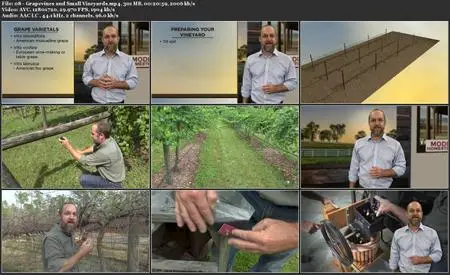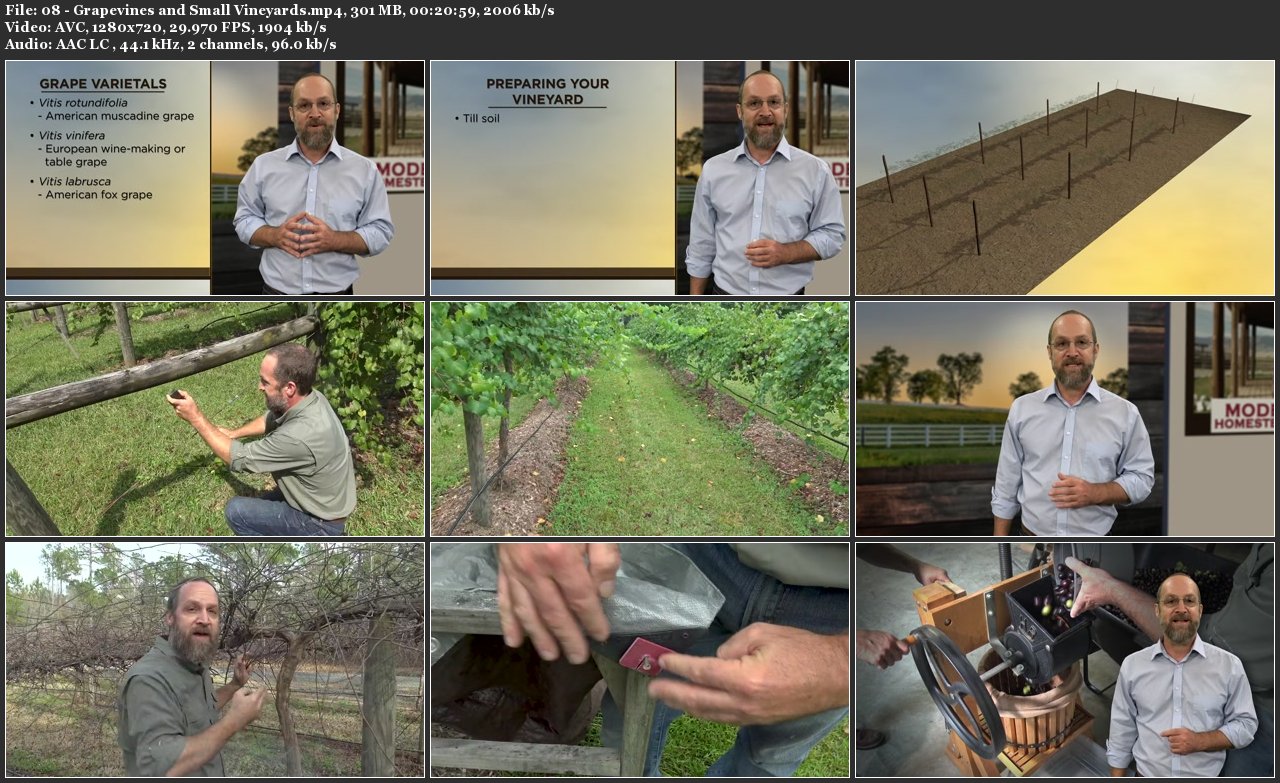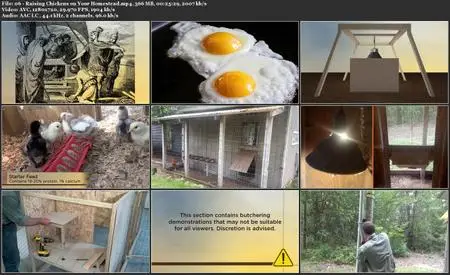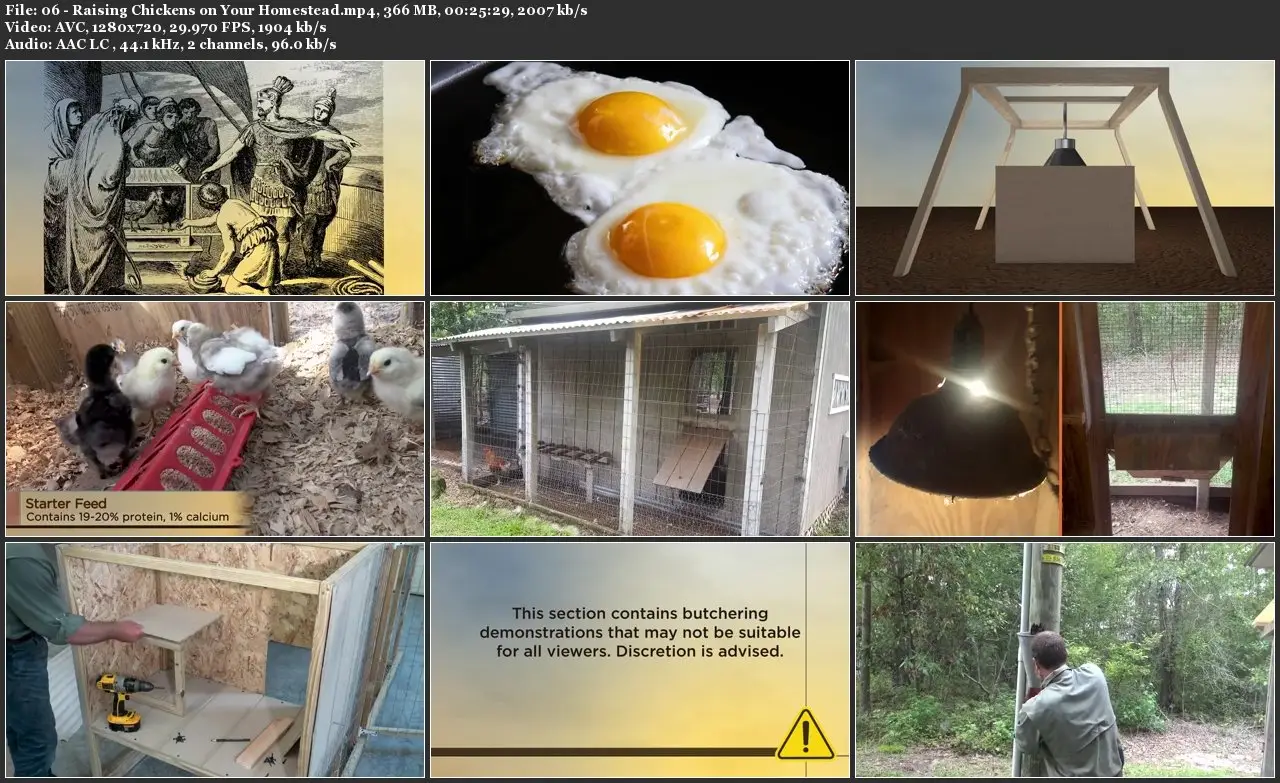TTC Video - Pioneering Skills for Everyone: Modern Homesteading
.MP4, AVC, 1280x720, 30 fps | English, AAC, 2 Ch | 10h 21m | 8.71 GB
Lecturer: Greg Pryor, PhD Professor, Francis Marion University | Course No. 9578
.MP4, AVC, 1280x720, 30 fps | English, AAC, 2 Ch | 10h 21m | 8.71 GB
Lecturer: Greg Pryor, PhD Professor, Francis Marion University | Course No. 9578
Have you ever dreamed of living off the land—growing or hunting all your own food, providing for your own energy and water needs, and building your own structures? Or maybe your dream doesn’t go quite that far. Maybe you’ve thought of growing tomatoes and zucchini in your urban backyard for delicious and pesticide-free summer fare or learning to make your own wine from the plentiful grapes at the farmer’s market.
No matter what your personal living-off-the-land dream looks like right now, and whether you have 100 acres all to yourself or you live in a city apartment, Pioneering Skills for Everyone: Modern Homesteading will bring you closer to that dream than you ever thought possible. In 24 exciting lessons with field demonstrations, you will learn how to grow a wide variety of produce in raised bed gardens or in back porch containers, the basics of soapmaking, how to pickle or ferment vegetables, the fundamental hand tools you will need for any project, and so much more.
Your guide, Professor Greg Pryor, knows every facet of modern homesteading and is clearly excited about the subject, presenting the information in clear, step-by-step language. Not only does Professor Pryor hold a PhD in zoology and serve as Professor of Biology at Francis Marion University in South Carolina, but he also lives on a 130-acre homestead and was raised in a rural setting in a home his father built with his own hands (and where he still resides today). Homesteading is not something Dr. Pryor learned from a book. His experiential, hands-on approach makes Pioneering Skills for Everyone more than just an intellectual approach to homesteading and gives you the real-world experience of living off of the land—no matter what that means for you personally.
Food Self-Sufficiency
One of the main reasons people are drawn to modern homesteading is to become food self-sufficient. This way, you know where it all comes from, and what is—and what is not—in the food you eat. In this course, you will learn how to become self-sufficient with respect to fruit, vegetables, dairy, and meat. With step-by-step instructions and in-field demonstrations, you will learn how to accomplish all the tasks needed to meet your own food needs, including:
How to build a raised bed for gardening, which is ideal for certain soil conditions and doesn’t require tilling. You’ll learn how to prepare the ground and how to build a four-foot-wide raised bed.
How to create the appropriate supports for your tomato plants and how to build a sturdy tomato cage from welded wire fencing with a temporary trellis line during the summer. Using T-posts for support and using stretch tie tape that won’t girdle the plant, your tomato garden will be in great shape.
How to milk goats to meet your dairy needs. Once the kid no longer solely depends on its mother for nutrition, you’ll be able to milk the nanny for your own needs. Following step-by-step instructions, milking will be comfortable for both you and the goat—after a bit of practice! With fresh goat milk, you’ll learn how to make paneer, chevre, ricotta, and mozzarella cheese.
Unless you’re committed to a vegetarian lifestyle, you’ll also want to process meat on your homestead. Pioneering Skills for Everyone: Modern Homesteading contains specific language and real-world demonstrations illustrating how to humanely kill and process the goats and chickens you raise yourself, as well as the deer, wild hogs, and rabbits you might hunt. Some of these demonstrations can be graphic in nature, but this course is designed so that you can pick and choose the lessons that work for you and disregard those that may make you uncomfortable or don’t fit the version of homesteading that you hope to pursue.
However, if you do want to process your own meat, you will learn the art of butchering by following a detailed visual guide. You could produce many pounds of meat from each goat, including loins, roasts, stew meat, and burgers. You will also learn how to process various small and large game mammals, fish, and birds.
What Tools Will You Need?
Chances are you already have some of the basic tools you would need for the modern homestead, even if you live in a city apartment—a good hammer, a cordless drill, tape measure, and duct tape, among others. Those tools will all come in handy. But if your homesteading dreams extend beyond the urban environment, you’ll need many additional tools for activities like building chicken coops, harvesting grapes, ridding your farming area of tree stumps, and much more.
In Pioneering Skills for Everyone: Modern Homesteading, your professor shares the knowledge he’s honed during his years of trial and error. When he first started homesteading, he used only hand tools, explaining that his goal was to be at one with nature. However, after a lot of experience, Professor Pryor decided some power tools would be a great idea. As he explains, he could certainly chop down a small tree with an axe or clear some light brush with a machete. But when it came to working 100-plus acres, power equipment saved the day—and his back.
Power tools are more expensive than hand tools, and you certainly don’t want to spend your money unnecessarily. In this course, you’ll learn which hand tools will work perfectly well around the homestead and which tasks really do require power tools, such as:
Rototiller, a motorized tiller with a series of rotating sharp tines that dig into the soil. If you’re breaking ground to make a new garden, or maintaining a large- or medium-sized garden, you’ll want a walk-behind, self-propelled tiller to do the job.
Chainsaw, a gasoline- or battery-powered saw that cuts with a set of sharp teeth attached to a moving chain. This is a powerful tool that will keep you from wearing yourself out using a regular saw—but it is a dangerous piece of equipment and you must pay attention to the safety instructions.
Walk-Behind, Self-Propelled Brush Mower, somewhat like the familiar suburban lawn mower—on steroids. This machine can cut through waist-high grasses and small saplings. Given that maintaining your homestead is a constant battle against encroaching natural vegetation, this power tool is a must.
Pioneering Crafts
When homesteading became popular in the United States—with the passage of the Homestead Act of 1862—many of the activities we now consider “old-fashioned crafts” were an absolute necessity. If you wanted clothes and quilts, you made them. If you wanted to eat in the winter, you preserved the foods you harvested in the summer or fall. And if you wanted to see inside your home after sundown, you made candles when you could.
But your modern homesteading doesn’t have to include any of these activities. You can pick and choose which aspects of homesteading hold the greatest appeal for you and implement them as you can, whatever your current situation. As you do, you’ll become more aware of your food sources and will eventually lessen your impact on the environment.
Whether you want to live off the grid or simply adapt your lifestyle to be more self-sufficient and eco-friendly, Pioneering Skills for Everyone: Modern Homesteading offers you the tools, techniques, and mindset necessary for you to engage meaningfully with the way you live and with how to prepare for what you want to accomplish while homesteading.
Your guide, Professor Greg Pryor, knows every facet of modern homesteading and is clearly excited about the subject, presenting the information in clear, step-by-step language. Not only does Professor Pryor hold a PhD in zoology and serve as Professor of Biology at Francis Marion University in South Carolina, but he also lives on a 130-acre homestead and was raised in a rural setting in a home his father built with his own hands (and where he still resides today). Homesteading is not something Dr. Pryor learned from a book. His experiential, hands-on approach makes Pioneering Skills for Everyone more than just an intellectual approach to homesteading and gives you the real-world experience of living off of the land—no matter what that means for you personally.
Food Self-Sufficiency
One of the main reasons people are drawn to modern homesteading is to become food self-sufficient. This way, you know where it all comes from, and what is—and what is not—in the food you eat. In this course, you will learn how to become self-sufficient with respect to fruit, vegetables, dairy, and meat. With step-by-step instructions and in-field demonstrations, you will learn how to accomplish all the tasks needed to meet your own food needs, including:
How to build a raised bed for gardening, which is ideal for certain soil conditions and doesn’t require tilling. You’ll learn how to prepare the ground and how to build a four-foot-wide raised bed.
How to create the appropriate supports for your tomato plants and how to build a sturdy tomato cage from welded wire fencing with a temporary trellis line during the summer. Using T-posts for support and using stretch tie tape that won’t girdle the plant, your tomato garden will be in great shape.
How to milk goats to meet your dairy needs. Once the kid no longer solely depends on its mother for nutrition, you’ll be able to milk the nanny for your own needs. Following step-by-step instructions, milking will be comfortable for both you and the goat—after a bit of practice! With fresh goat milk, you’ll learn how to make paneer, chevre, ricotta, and mozzarella cheese.
Unless you’re committed to a vegetarian lifestyle, you’ll also want to process meat on your homestead. Pioneering Skills for Everyone: Modern Homesteading contains specific language and real-world demonstrations illustrating how to humanely kill and process the goats and chickens you raise yourself, as well as the deer, wild hogs, and rabbits you might hunt. Some of these demonstrations can be graphic in nature, but this course is designed so that you can pick and choose the lessons that work for you and disregard those that may make you uncomfortable or don’t fit the version of homesteading that you hope to pursue.
However, if you do want to process your own meat, you will learn the art of butchering by following a detailed visual guide. You could produce many pounds of meat from each goat, including loins, roasts, stew meat, and burgers. You will also learn how to process various small and large game mammals, fish, and birds.
What Tools Will You Need?
Chances are you already have some of the basic tools you would need for the modern homestead, even if you live in a city apartment—a good hammer, a cordless drill, tape measure, and duct tape, among others. Those tools will all come in handy. But if your homesteading dreams extend beyond the urban environment, you’ll need many additional tools for activities like building chicken coops, harvesting grapes, ridding your farming area of tree stumps, and much more.
In Pioneering Skills for Everyone: Modern Homesteading, your professor shares the knowledge he’s honed during his years of trial and error. When he first started homesteading, he used only hand tools, explaining that his goal was to be at one with nature. However, after a lot of experience, Professor Pryor decided some power tools would be a great idea. As he explains, he could certainly chop down a small tree with an axe or clear some light brush with a machete. But when it came to working 100-plus acres, power equipment saved the day—and his back.
Power tools are more expensive than hand tools, and you certainly don’t want to spend your money unnecessarily. In this course, you’ll learn which hand tools will work perfectly well around the homestead and which tasks really do require power tools, such as:
Rototiller, a motorized tiller with a series of rotating sharp tines that dig into the soil. If you’re breaking ground to make a new garden, or maintaining a large- or medium-sized garden, you’ll want a walk-behind, self-propelled tiller to do the job.
Chainsaw, a gasoline- or battery-powered saw that cuts with a set of sharp teeth attached to a moving chain. This is a powerful tool that will keep you from wearing yourself out using a regular saw—but it is a dangerous piece of equipment and you must pay attention to the safety instructions.
Walk-Behind, Self-Propelled Brush Mower, somewhat like the familiar suburban lawn mower—on steroids. This machine can cut through waist-high grasses and small saplings. Given that maintaining your homestead is a constant battle against encroaching natural vegetation, this power tool is a must.
Pioneering Crafts
When homesteading became popular in the United States—with the passage of the Homestead Act of 1862—many of the activities we now consider “old-fashioned crafts” were an absolute necessity. If you wanted clothes and quilts, you made them. If you wanted to eat in the winter, you preserved the foods you harvested in the summer or fall. And if you wanted to see inside your home after sundown, you made candles when you could.
But your modern homesteading doesn’t have to include any of these activities. You can pick and choose which aspects of homesteading hold the greatest appeal for you and implement them as you can, whatever your current situation. As you do, you’ll become more aware of your food sources and will eventually lessen your impact on the environment.
Whether you want to live off the grid or simply adapt your lifestyle to be more self-sufficient and eco-friendly, Pioneering Skills for Everyone: Modern Homesteading offers you the tools, techniques, and mindset necessary for you to engage meaningfully with the way you live and with how to prepare for what you want to accomplish while homesteading.







